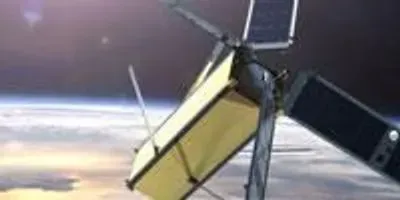 Artist rendering of the Radiometer Assessment using Vertically Aligned Nanotubes (RAVAN) satellite, a new, low-cost cubesat mission led by the Johns Hopkins Applied Physics Laboratory in Laurel, Md. RAVAN will demonstrate technology needed to measure the absolute imbalance in the Earth's radiation budget for the first time; the cubesat is scheduled for launch in 2015. Image Credit: JHU/APLA new, low-cost cubesat mission led by the Johns Hopkins Applied Physics Laboratory in Laurel, Md., will demonstrate technology needed to measure the absolute imbalance in the Earth's radiation budget for the first time, giving scientists valuable information to study our climate.
Artist rendering of the Radiometer Assessment using Vertically Aligned Nanotubes (RAVAN) satellite, a new, low-cost cubesat mission led by the Johns Hopkins Applied Physics Laboratory in Laurel, Md. RAVAN will demonstrate technology needed to measure the absolute imbalance in the Earth's radiation budget for the first time; the cubesat is scheduled for launch in 2015. Image Credit: JHU/APLA new, low-cost cubesat mission led by the Johns Hopkins Applied Physics Laboratory in Laurel, Md., will demonstrate technology needed to measure the absolute imbalance in the Earth's radiation budget for the first time, giving scientists valuable information to study our climate.
The Radiometer Assessment using Vertically Aligned Nanotubes (RAVAN) satellite, scheduled for launch in 2015, will demonstrate how accurate and wide-ranging measurements of Earth's outgoing radiation can be made with a remarkably small instrument. The RAVAN team includes partners at Draper Laboratory in Cambridge, Ma.; L-1 Standards and Technology in New Windsor, Md.; and NASA's Goddard Space Flight Center in Greenbelt, Md.
"Under stable climate conditions, the energy from the sun reaching the top of Earth's atmosphere and that being reflected or radiated to space are equal," explains Bill Swartz, an atmospheric scientist at APL and RAVAN principal investigator. "There is substantial evidence that they are not equal, and that difference is known as Earth's radiation imbalance (ERI). It's a really small number — a difference thought to be less than one percent — but that imbalance drives the future of climate change. RAVAN will demonstrate how ERI can be unambiguously and affordably quantified from space, enabling a huge leap in our ability to predict the future climate."
RAVAN will use a small, accurate radiometer, developed at L-1 Standards and Technology and not much larger than a deck of cards, to measure the strength of the Earth's outgoing radiation across the entire spectrum of energy — from the ultraviolet to the far infrared. "ERI is too small to be measured by previous, current or planned future space assets," says co-investigator Warren Wiscombe, a climate scientist at Goddard.
The secret to RAVAN's precise measurements is a "forest" of carbon nanotubes, grown at APL, that serve as the radiometer's light absorber. "The carbon nanotubes are a very deep black across the energy spectrum, which will let the radiometer gather virtually all the light reflected and emitted from the planet," says Swartz.
RAVAN represents the first step toward a constellation of cubesats, each no larger than a loaf of bread, that would provide global coverage of Earth's total outgoing radiation throughout the day and night, and data to answer long-standing questions about the Earth's climate future.
"RAVAN is unique because it's not only a technology demonstration but a manufacturing and economic demonstration," says Draper Laboratory's Lars Dyrud, RAVAN project lead. "Resolving climate uncertainty and improved prediction of future climate change requires 30 to 40 RAVAN sensors. The cubesat revolution and advanced manufacturing offer the best hope for affordably achieving these urgent goals." Draper Laboratory is responsible for process engineering for RAVAN, with the goal of ensuring that the instrument design can be manufactured in a cost-effective manner.
RAVAN is the first Earth science cubesat built by APL. It is part of the Lab's ongoing development and refinement of these small, adaptable and cost-effective platforms for operational use. APL's first two cubesats carried technology demonstration payloads, and launched Nov. 19, 2013, aboard a Minotaur rocket from Wallops Island. The RAVAN mission is sponsored by NASA's Earth Science Technology Office, located at Goddard.
A new, low-cost cubesat mission led by the Johns Hopkins Applied Physics Laboratory in Laurel, Md., will demonstrate technology needed to measure the absolute imbalance in the Earth's radiation budget for the first time, giving scientists valuable information to study our climate.
The Radiometer Assessment using Vertically Aligned Nanotubes (RAVAN) satellite, scheduled for launch in 2015, will demonstrate how accurate and wide-ranging measurements of Earth's outgoing radiation can be made with a remarkably small instrument. The RAVAN team includes partners at Draper Laboratory in Cambridge, Ma.; L-1 Standards and Technology in New Windsor, Md.; and NASA's Goddard Space Flight Center in Greenbelt, Md.
To continue reading this article, sign up for FREE to

Membership is FREE and provides you with instant access to eNewsletters, digital publications, article archives, and more.












